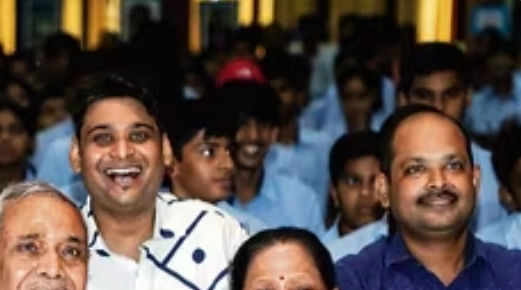
At 3:01 pm IST on Tuesday, SpaceX’s Dragon Grace spacecraft splashed down in the calm waters of the Pacific Ocean off the west coast of the US at the end of a 22.5-hour journey from the International Space Station (ISS).
Inside were Group Captain Shubhanshu Shukla, only the second Indian to go to space, and the Indian to have spent most time there, and three of his Axiom-4 (Axe-4) mission crewmates.
Shortly after Shukla, who was all smiles, was assisted out of the capsule onto the recovery vessel, Prime Minister Narendra Modi on X said, “I join the nation in welcoming Group Captain Shubhanshu Shukla as he returns to Earth from his historic mission to Space. As India’s first astronaut to have visited the International Space Station, he has inspired a billion dreams through his dedication, courage and pioneering spirit. It marks another milestone towards our own Human Space Flight Mission - Gaganyaan.”
Congratulating Shukla, President Droupadi Murmu said on X, “A hearty welcome to Group Captain Shubhanshu Shukla as he comes back on Earth after his space journey. His role in piloting Mission 4 to the International Space Station has created a new milestone for India’s space exploration as well as for international collaboration in science and technology.”
As per protocol, the crew underwent the first medical examination in SpaceX’s recovery vessels. They will undergo a week’s rehabilitation programme under the supervision of flight surgeons to enable them to adapt back to Earth’s gravity. After 20 days in space, of which 18 days were spent living and working in the lower orbiting laboratory, the Axe-44 crew took in their first breath of fresh air.
On June 25, the Falcon 9 rocket lifted off the spacecraft from Launch Complex 39A at Kennedy Space Centre in Florida. It reached ISS on June 26 after a 28-hour journey. Shukla became the second Indian astronaut in space since 1984, and the first in the country on ISS. Alongside Shukla, the Axe-4 mission marked the return to human spaceflight programme for India, Poland and Hungary in over four decades.
Representing the Indian Space Research Organisation (ISRO), Shukla’s return with all the learnings and experience from the Axe-4 mission is an important step for the Gaganyaan mission and setting up the Bharatiya Antariksh Station (the Indian Space Station).
Union Minister for Science and Technology Jitendra Singh also congratulated the Axe-4 team.
“Congratulations, Team #Axiom4! A moment of pride for the world as “Dragon” successfully splashes down off the California coast near San Diego. A moment of glory for India as one of her illustrious sons returns from a successful voyage… having conducted for posterity, life-bearing experiments in microgravity, never done before. Bharat today finds an enduring Space in the world of Space!” he said on X.
The Department of Space has termed Shukla’s mission as one of strategic importance and India’s resolve to emerge as a serious contender in human space exploration. Former Isro chairperson S Somanath said, “Super excited to witness the successful return of Group Captain Shubhanshu Shukla and fellow astronauts to Earth just moments ago! The insights and experience gained by Shux during this mission will add immense value to Team Gaganyaan as we prepare for India’s first human spaceflight.”
On July 14 at 4.45 pm IST, the Axe-44 crew began their journey to Earth after the Dragon spacecraft autonomously undocked from the space-facing port on the Harmony module of ISS after spending approximately 433 hours, 18 days, and 288 orbits around Earth, covering nearly 7.6 million miles.
Twenty minutes before splashdown, there was around a six-minute communication blackout as the capsule, on entering Earth’s atmosphere, got heated due to the plasma buildup pushing the temperature to 1926.6 degrees Celsius.
2.54 pm4pm, Axiom Space live-streamed the first visuals of the capsule. As the two drogue parachutes were released at around 5.5km to stabilise descent, the seats inside the capsule underwent a rotation that caused the crew to sit upright in preparation for the final descent and splashdown. About 1.8km away, the main parachutes were deployed to further slow down the capsule to a safe splashdown speed from 350 miles per hour to 15 miles per hour.
Soon after the splashdown off the coast of California, teams from SpaceX and Axiom got into swift action. Overnight, SpaceX had prepositioned its recovery teams, two fast boats and the recovery vessel to extract the capsule from the waters with a hydraulic lift. While teams from one fast boat undertook leak checks of the capsule and the second team picked up the parachutes, teams on the recovery vessel were pressed into action.
At 3.40 pm, the side hatch of the partially burnt Grace was opened. Sliding out of the capsule, the crew who had spent 18 days floating in microgravity were assisted to take their first few steps in gravity. The crew also returned with more than 580 pounds of cargo, including NASA hardware and data from over 60 experiments conducted throughout the mission.
For India, Shukla completed seven indigenously developed microgravity experiments and undertook five scientific experiments as part of the ISRO-NASA collaboration.
Shukla’s family celebrated his return on Tuesday. His mother Asha Shukla told ANI, “I don’t have words to express my happiness...PM Modi also congratulated him...Excitement is endless, and we are very proud. We were afraid at first... The upcoming generation should take inspiration and move ahead as well...”
The Group Captain’s father expressed his urge to meet his son as soon as possible. “Now we want to meet him as soon as possible...We were praying for his safe return to earth...” Shambhu Dayal Shukla told ANI.
Isro, in a statement late Tuesday, said he completed the Axe-44 mission and Shukla’s return “marks a proud moment both for ISRO and India”.
“Gaganyatri Shubhanshu Shukla is now undergoing a structured post-mission medical evaluation and recovery protocol under the supervision of Axiom Space and ISRO flight surgeons. This program, spanning seven days, includes cardiovascular assessments, musculoskeletal tests, and psychological debriefs aimed at ensuring full physiological recovery and data capture for future missions,” read the statement.
Through the 20 days, ISRO’s Mission operations team continued to stay in Houston, gaining first-hand experience in managing human spaceflight operations. “The team was embedded alongside NASA and Axiom flight controllers, participating in real-time decision-making, telemetry tracking, crew timeline management, and health monitoring of both the astronaut and the science payloads. This exposure provided critical insights into international crewed mission coordination, emergency response protocols, and the complexities of orbital operations,” said Isro, adding that the collaborative mission will help in building India’s own crewed mission operations infrastructure, enhancing readiness for future indigenous human spaceflight programs such as Gaganyaan and the Bhartiya Antariksha Station.
-
'Blood Money' Reports Jeopardise Nimisha Priya's Pardon? Social Worker Says Victim's Family Angry

-
If you are not getting time to apply mehndi in Sawan, try this trick to look beautiful to hands

-
Sudden death of student in Sikar: worry about heart diseases

-
You will find success yourself, every dream will be fulfilled, this Japanese technology will give life

-
Not a husband’s words, the words of a friend have started coming, somewhere this romantic attraction is not
